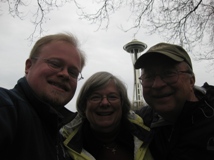Space Saturday XIII
Both Sky and Telescope and APOD beat me to the punch, but I won’t let that stop me. This week I bring you M1: The Crab Nebula:
Source: NASA, ESA, J. Hester and A. Loll (Arizona State University)
The Crab Nebula is a supernova remnant (the supernova, which was recorded in the 11th century was apparently visible for nearly a month in daylight!) located in the constellation Taurus some 6500 light years away. This HST photo from five years ago was just realsed to the public on thursday. The stunning image shows gorgeous structure in the 6 light year wide expanding nebula.
The orange filaments are the tattered remains of the star and consist mostly of hydrogen. The rapidly spinning neutron star embedded in the center of the nebula is the dynamo powering the nebula’s eerie interior bluish glow. The blue light comes from electrons whirling at nearly the speed of light around magnetic field lines from the neutron star. The neutron star, like a lighthouse, ejects twin beams of radiation that appear to pulse 30 times a second due to the neutron star’s rotation. A neutron star is the crushed ultra-dense core of the exploded star.
Click the image for a larger version or this link for a larger 1280×1024 image.
Resources
HubbleSite: A Giant Hubble Mosaic of the Crab Nebula
SEDS: M1
APOD: Crab Nebula Mosaic from HST
Wikipedia: Crab Nebula
Sky and Telescope: Hubble Dissects the Crab
AAS 205th Meeting: HST WFPC2 Imaging of the CRAB NEBULA EJECTA
Check out my other astronomy photographs at my Space Saturday Archive.
-Matt Jones




One of my friends had the Thanksgiving APOD.
As for why they only just released the image, there’s a few reasons to it. Firstly, all data taken by the HST is proprietary for the first year - that means it’s private property of the astronomers who had the time on the telescope. Making it proprietary is to reward them for doing the work of writing the propsal; making it only a year long is to encourage them to then write it up fast, and to eventually make the data public as is required at US government instututions. So in other words, you won’t typically see pretty pictures like this until at least a year after the data is taken, as the astronomers go for the science rather than the pretty.
Additionally, there’s been much more data taken than can be turned into pretty pictures by the small numbers of people (Hubble affiliated and not) working on the pretty pictures. So they pick and choose what they want to do from the HST archives and release them as theyr’e done.
FYI, It’s unclear to me how much contribution was made by an amateur working on the project. He was acknowledged in the APOD article you quoted, but not the HubbleSite. His own page says that there was some VLT contribution as well, though HubbleSite does not acknowledge that - are they the same image? This is the problem with pretty pictures… The one nice thing about it though is it finally helps me see where the x-ray images line up with the visible, as the blue glow in the middle appears to have the same shape as the x-ray image.
Hey, give me a little credit, I do have a degree in physics and astronomy - I know why it was just released! But thanks for that comment, I am sure there are many others that don’t.
But thanks for that comment, I am sure there are many others that don’t.
The credit is also somewhat unclear to me, I am more willing to believe the HubbleSite though. It seems that the image is purely Hubble’s optical image, but the VLT may have been involved in som other aspect, but I really don’t know… just me being ignorant.
I was tempted to show the X-Ray image as well, but I thought it would just confuse things a bit. But the x-ray image is extremely striking, it is truly amazing how much more is going on that we can’t see!